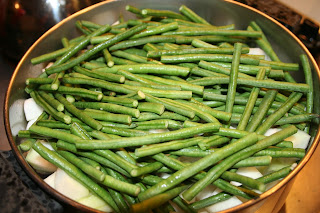I was at the Asian market and saw long green beans next to the eggplant and immediately started to crave pinakbet, or at least a more subtle version of it. I love the flavors and textures of this dish. I’m not Filipino or very fond of bitter mellon or okra which I know is traditional but I love the stewed vegetable combination flavored with fish sauce.
Pinakbet is an Ilicano vegetable dish that, according to wikipidia, translates into "shrunk" or "shriveled" usually flavored with pork. The best way that I can think of to describe pinakbet is that it is sort of the Filipino version of the better known French ratatouille. Pinakbet is a comforting melody of vegetables that are stewed together usually flavored with bagoong, which is an extremely potent fish or shrimp paste. The flavor is much too strong for my family so I leave it out and use patis (fish sauce) instead. By substituting the patis for the bagoong I still get the intended fish flavor in the background without the pungent nose and palate hit that bagoong releases favoring the vegetables gently instead of over powering them. I cook to please my family, but for my portion I punch up the fish flavor by adding a touch more patis to my serving.
I realize that most Filipino’s would disagree with my choice to leave out the bagoong, but my family won’t allow it. The Chinese have their own version of bagoong it’s called harm ha and if my family could tolerate the smell I would eat it more often. It has the same nasty aroma that bagoong releases. The aroma is deceiving because the flavor that hits your palate is delicious.
To make clear as to how stinky bagoong and harm ha are I will share a couple of stories. Years ago when my mother-in-law was making harm ha pork one of her Haole (white) neighbors came out of her apartment shouting that the sewer line had broken and the stench was permeating the neighborhood. My mother-in-law replied, no, that’s just my dinner. My friend Karen told me that when she makes harm ha pork, that first her family clears out of the house, soon to be replaced with fly’s swarming outside her kitchen screen window, a true sign that she is making it right.
I don’t really have a recipe as much as a guide to making this dish so I shot a photo to give you a general idea as to how much of what to use. Also, I used opo squash, most any squash will work but I think if its available kabocha squash would be best. With its orange flesh this is tender-smooth and sweet.
(from top left to bottom right) tomatoes, long green beans, eggplant, squash, onions and garlic.
MY PINAKBET
½ pound pork, sliced thin
½ cup water
3 Tbsp. patis, fish sauce
2 cloves garlic
½ large onion
1 bunch Long beans, cut into 2-3” lengths
1 long Chinese egg plant, cut into 1” pieces
1 med squash, diced
2 large tomatoes, diced
Heat a stew pot over med-high with about 1-2 Tbsp. oil and brown pork.
Add onions and garlic and cook just until they are fragrant.
Add the vegetables in layers, starting with the tomatoes.
Pour over the water and fish sauce and bring to a boil. Cover and cook undisturbed for 15 - 20 minutes or until vegetables are tender. Stir and serve over rice.







I am also hesitant to use bagoong or shrimp paste to my pinakbet recipe. I am Filipina but my husband is white. I would have to try fish sauce so He and our neighbors won't smell the aroma of the shrimp paste. I will see later on, if the taste of pinakbet is at least comparable to our authentic and famous pinakbet at home. Thanks for sharing this!
ReplyDeleteLet me know what you think and of course... what your husband thinks :)
Delete